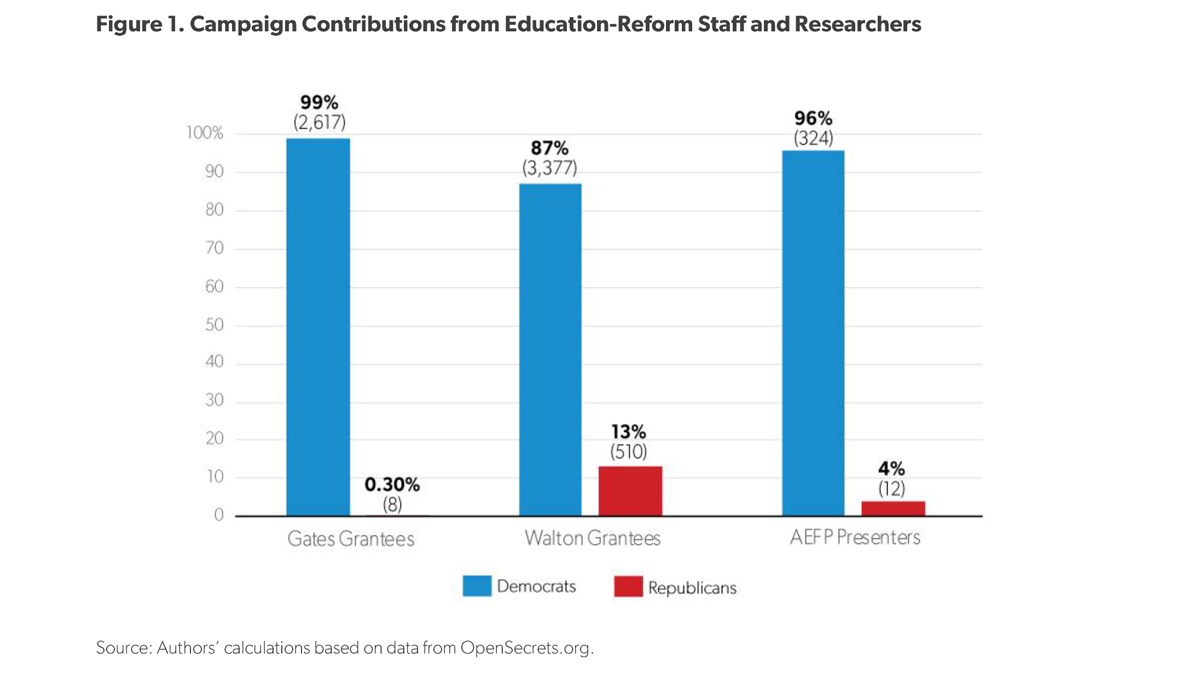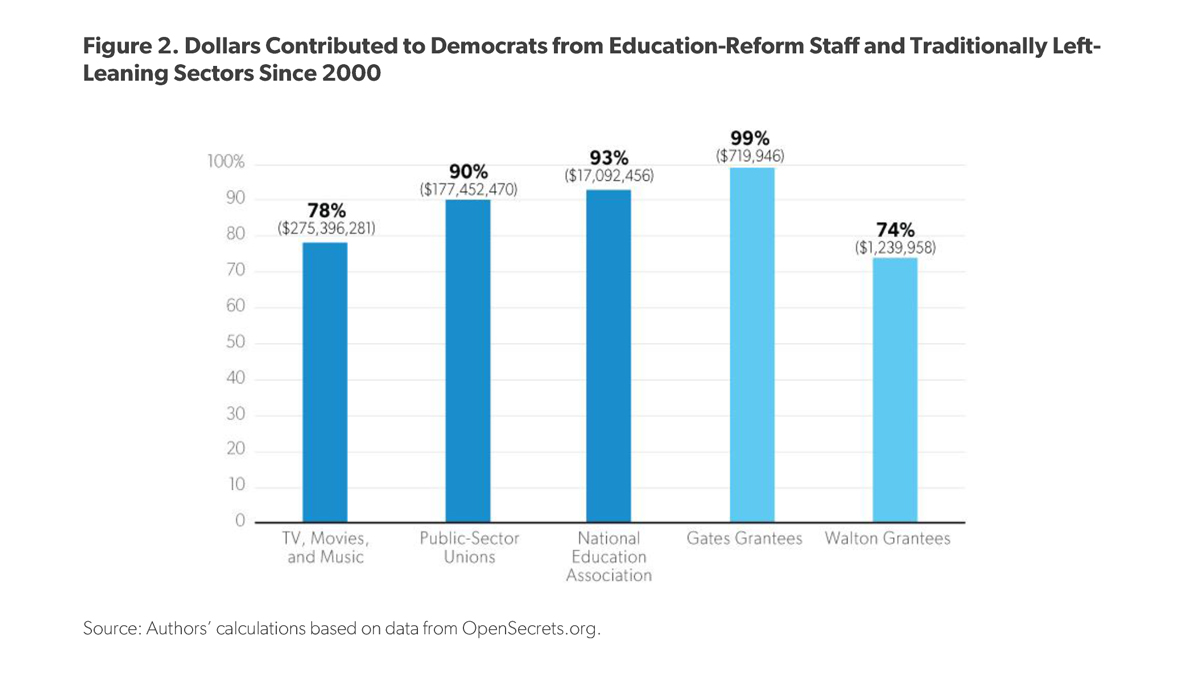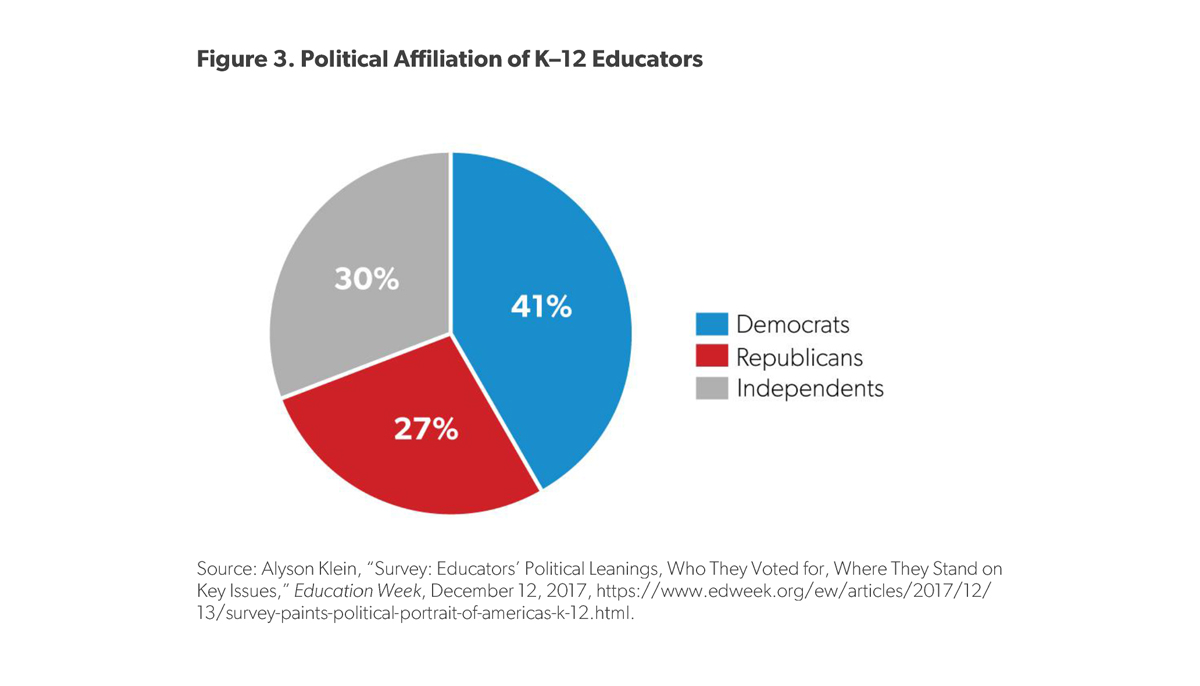
Close observers of 21st-century education reform know that champions of charter schooling, teacher evaluation, and accountability are routinely characterized as right-wingers bent on undermining public education. Thus, the education-reform battles tend to be depicted as left versus right or blue versus red, with progressive teachers unions and their allies fending off the attacks of right-wing reformers.
These tropes are omnipresent. The most visible symbols of education reform—such as Teach for America (TFA) and various charter school networks and the foundations that fund them—are characterized as neoliberal, corporatist, conservative, and right-wing. In the Atlantic, the KIPP charter schools have been attacked for their role “in the project of neoliberalizing public goods.” [1] Success Academies founder Eva Moskowitz has been excoriated for promoting a Trojan horse that contains “Donald Trump and Betsy DeVos.” [2] The Walton Family Foundation has been dismissed as “conservative” or “deeply conservative” by the Huffington Post [3] and historian Diane Ravitch. [4]
Regarding Teach for America, Rethinking Schools has published “An Open Letter to New Teach for America Recruits,” which reads: “Many of you no doubt believe you are joining a progressive education justice movement; that is the message TFA sells so well. But TFA is not progressive. The data-driven pedagogy, the fast-track preparation, the union-busting, the forced exploitation of your labor, the deep-pocketed affiliation with corporate education reform are all very conservative, very anti-progressive ideas.” [5]
Meanwhile, education-reform advocates describe their efforts as bipartisan, nonpartisan, and centrist. For instance, Chiefs for Change describes itself as a “bipartisan network of diverse state and district education Chiefs.” [6] Stand for Children touts its “bold independence” and bills itself as “non-partisan and child-focused.” [7] Advocacy group 50CAN explains that it is a “nonpartisan, research-backed organization driven forward by the work of a talented, energetic and diverse staff.” [8] As one Teach for America board member put it a couple years ago, “We’re not living in pragmatic centrist times, but TFA is a pragmatic, centrist-oriented solution.” [9]
So, who is right? Is 21st-century education reform a right-wing project or a purple, bipartisan one? Well, if one considers the candidates whom education reformers support for public office, the answer turns out to be neither.
While it is not practicable to examine the voting habits or partisan affiliations of education reformers, we can identify the candidates and political causes to which they contribute. And the pattern of their political giving suggests that the people who work at the education-reform organizations that the biggest and best-known education-reform foundations support are almost uniformly left-leaning. In other words, education reform turns out to be neither a red nor a purple enterprise—but a deep blue one.
Of course, after a moment’s reflection, this ought not be so surprising. Teach for America chapters, charter school groups, and education-advocacy groups such as the Education Trust and Stand for Children have gone out of their way in recent years to demonstrate their progressive bona fides (and disagreement with Republicans) on issues such as immigration, [10] school discipline, [11] transgender access, [12] and school vouchers.[13]
In this new analysis, which examines the political campaign contributions from those most active in education reform, we find that the movement is populated by individuals who support Democratic candidates for public office. The bottom line: The leading participants in the school-reform “wars” are mostly engaged in an intramural brawl, one between union-allied Democrats and a strand of progressive Democrats more intent on changing school systems.
Data and Methods
To gauge the partisan composition of the reform movement, we examined the political campaign contributions of a large sample of individuals working in education-reform organizations. To identify the sample, we compiled a list of grantees receiving support from the Bill and Melinda Gates Foundation and the Walton Family Foundation. We examined Gates and Walton grantees because those two foundations are the largest funders of the education-reform movement, each giving almost $200 million annually to the effort. Indeed, the lion’s share of organizations working in education reform receive support from one or both of those foundations.
To identify Gates and Walton grantees, we used their most recent annual reports. The Gates education policy grantees can be found in the “K–12 Education” and “Postsecondary Success” sections. [14] The Walton grantees can be found in the “K–12 Education” section. [15] We coded results for all grantees receiving at least $500,000 and for a sample of grantees receiving less. This means that the grantees we examined are somewhat, but not perfectly, weighted by the amount of support they receive. We did exclude grantees that have too many activities and facets to be described as solely focused on shaping education policy. For example, we excluded universities and large, urban school districts that were listed as grantees. (The Gates and Walton foundations list only the organizations receiving grants, not the specific individuals or units within organizations; this makes it impossible to ascertain the purpose of grants directed to large, multifaceted recipients.)
To gauge the partisan tilt of those receiving support from the Gates and Walton foundations, we searched for political campaign contributions by people who listed those organizations as their employer on campaign-contribution forms. A database of campaign contributions searchable by employer can be found on OpenSecrets.org. [16] We recorded every campaign contribution from every person who listed the Gates or Walton grantee as their employer. OpenSecrets.org appears to track political contributions as far back as 1998, but the vast majority of contributions we examined were within the past decade.
We classified each contribution as supporting Democrats or Republicans. For contributions to individual candidates, OpenSecrets.org lists the candidate’s party affiliation. For contributions to political action committees (PACs), OpenSecrets.org typically labels the party orientation of the PAC and the percentage of PAC funds going to support candidates of each party. If a PAC was labeled as affiliated with a party or more than 90 percent of its funds went to one party, we classified contributions to that PAC as supporting the party in question. Only a small share of contributions could not be classified by party.
Individuals may give multiple contributions to candidates of different parties within an election cycle or across election cycles. For this reason, our main unit of analysis is contributions, not individuals. That is, we classified each contribution as supporting Democrats or Republicans. We also recorded the dollar value of each contribution, making it possible to examine the percentage of all dollars contributed that supported each party.
Results
We tracked political campaign contributions for staff with a sample of 73 organizations receiving support from the Gates Foundation (out of a total of 197 education-reform organizations identified in the foundation’s financial report). Of the 73 organizations examined, 47 had staff that made contributions. These Gates grantees included leading education-reform organizations such as Achieve Inc., Teach for America, the New Schools Venture Fund, KIPP, Alliance for Excellent Education, Jobs for the Future, Turnaround for Children, and Bellwether Education Partners.
In total, we found 2,625 political campaign contributions from the staff of Gates grantees. Of those contributions, 99 percent supported the Democratic Party or Democratic candidates (Figure 1). Only eight of the 2,625 campaign contributions went to Republicans. The picture is similar when one examines the dollars contributed to each party or its candidates. Of the $725,464 in campaign contributions the staff of Gates grantees made, $719,946, or 99 percent, went to Democrats—while just $5,500, or less than 1 percent, went to Republicans.
The political imbalance among Walton grantees was modestly less pronounced than among Gates grantees. Given that the Walton Family Foundation has a larger set of grantees, we tracked results for a sample of 194 organizations receiving support from Walton (drawn from the 380 organizations listed in the foundation’s financial report). Of those 194 organizations, 125 had at least one staffer make a recorded campaign contribution. These Walton grantees included organizations such as Teach for America, KIPP, Education Reform Now, 50CAN, the 74 Media, Chalkbeat, and the Education Trust.
In total, we found 3,887 political campaign contributions from employees of these 125 organizations. Of these contributions, 3,377, or 87 percent, went to Democrats. On average, the dollar value of contributions to Republicans among Walton grantees was higher than those to Democrats. As a result, 74 percent, or $1,239,958 of the $1,685,207 in total contributions, went to Democrats. Whether measured in contributions or funds contributed, staff at grantees of the “very conservative” Walton Foundation clearly favor Democratic candidates over Republican ones by a margin of somewhere between 3-to-1 and 7-to-1.
Scholars of Education Reform
We conducted a similar analysis for a set of scholars who focus on education reform: the presenters at the most recent conference of the Association for Education Finance and Policy (AEFP). We examined the presenters at AEFP because of their investment in evaluating reform initiatives such as charter schooling, school turnarounds, and teacher-evaluation systems. AEFP is different from the much larger and older American Education Research Association, whose members include most of the nation’s education professoriate and are generally skeptical of policies such as school choice and test-based accountability. Indeed, AEFP split from the American Education Finance Association to create a research organization more hospitable to the analysis and discussion of reform. AEFP’s membership is drawn, in large part, from public policy and economics departments. In short, AEFP can be understood as encompassing many of the more reform-minded economists and econophiles who study education. Given that, it seems worth exploring the degree to which AEFP is home to more conservative, Republican-friendly academics.
To compile our AEFP sample, we identified the names and institutional affiliations of everyone who was listed as a presenter at AEFP’s 2018 conference [17] and then searched OpenSecrets.org for each individual to identify their campaign contributions.
In total, we looked up information on all 749 scholars who presented at the AEFP 2018 national conference. Of those 749, we found at least one campaign contribution from 74 people. Those 74 people made a total of 336 contributions worth $78,308. Of those 336 contributions, 324, or 96 percent, went to Democrats. And of that $78,308, $75,958, or 97 percent, went to Democrats. Of the 74 AEFP presenters who made campaign contributions, only four had ever given to even a single Republican. Like the Gates and Walton grantees, AEFP is almost entirely populated with people who support the Democratic Party.
Information on AEFP conference participants also allows us to glean some sense of how politically active education reformers are. For Gates and Walton grantees, we do not know the universe of employees who might have given. But for AEFP, we know that 74 of 749, or 10 percent, of people have contributed to political campaigns. According to OpenSecrets.org, only 0.68 percent [18] of the adult US population made campaign contributions during the 2016 election cycle exceeding the $200 minimum requiring that a form be completed. If we restrict our AEFP sample to the 2016 election cycle and eliminate those who gave less than $200, we see that 23, or 3.07 percent, of the AEFP sample contributed, relative to 0.68 percent for the general population. That means that AEFP presenters contributed to campaigns at about four to five times the rate of American adults.
The hundreds of researchers and analysts involved in AEFP are an important constituency in the education-reform world. Their evaluations and scholarship help shape public understanding of education reform and whether it works. Thus, that the ideological views of those who study education reform align with those pursuing those efforts raises useful questions about the role of potential biases, blind spots, and groupthink.
Putting the Findings in Perspective
Remarkably, the deep blue hue of Gates and Walton education grantees (and reform-friendly education researchers) rivals the leftward lean we see in Democratic precincts such as Hollywood and public-employee unions. For instance, the Center for Responsive Politics, which operates OpenSecrets.org, reports that 78 percent of campaign contributions from the TV, movies, and music industry have gone to Democrats since 2000. [19] If we consider only movie production and distribution (e.g., producers, actors, directors, technicians, and agents), then 90 percent of the contributions made since 2000 went to Democrats. [20]
Meanwhile, public-sector unions have given 90 percent of their contributions to Democrats over the past two decades. In other words, Hollywood and public-employee unions are just as liberal as advertised, but the allegedly right-wing ranks of K–12 education reformers turn out to be every bit as one-sided in their partisanship (Figure 2).
Some readers may wonder whether education reform leans toward Democrats simply because everyone in K–12 education is a Democrat. In a word: Nope. For instance, Education Week polling reports that just 41 percent of educators identify as Democrats, with 27 percent identifying as Republicans and 30 percent as independents. [21] Even the National Education Association (NEA), the nation’s largest teacher union, gives a larger slice of its campaign contributions to Republicans than do the employees of Gates education grantees (Figure 3). Since 2000, 93 percent of NEA PAC money has gone to Democrats. [22] Staff of the grantees funded by the “very conservative” Walton Foundation are barely more favorable to Republicans than are members of the nation’s largest teacher union.
Why This Matters
These results paint a surprising picture of education reform: one of a movement dominated by Democratic partisans. In fact, the school-reform community’s leftward tilt is wholly at odds with the popular narrative that school reform is the project of right-wing privatizers—and with reformers’ claims that theirs is a centrist, bipartisan movement. Indeed, it is fair to wonder how these depictions have become so detached from the reality of who populates the world of education reform.
This lack of right-leaning representation has important implications for education reform’s practice, popularity, and political prospects. Given the paucity of Republicans (or of individuals inclined to support Republican candidates), it is no great surprise that school reform seems to reflect the politically progressive impulses of the contemporary left. One consequence is that this (overlooked) ideological homogeneity may create an echo chamber that hinders the movement’s ability to detect and address political and practical challenges. These risks are heightened by reformers laboring under the mistaken impression that their coalition is politically and ideologically diverse—when the data suggest it is not.
Education reform’s political uniformity also has implications for its political prospects. More so than in many major policy areas, K–12 policy is shaped at the state and local level. Especially given that two-thirds or more of the states are conservative or politically contested—including such reform bellwethers as Colorado, Indiana, Louisiana, and Tennessee—reform suffers to the extent that it struggles to anticipate and address Republican concerns or speak credibly to Republican audiences. Indeed, unencumbered by Republicans in their midst, school reformers have found themselves energetically embracing aggressive progressive stances on hot-button issues such as immigration, tax policy, and gun control. Meanwhile, given the ongoing resistance to reform from prominent Democratic constituencies, a Democrats-only reform coalition faces a natural ceiling on its prospects.
All this matters for at least three reasons. First, that education reform appears to be populated by Democrats raises obvious questions about the political and ideological breadth of the movement. A coalition whose staff and scholars are so identified with one political party is likely to suffer when forging bipartisan coalitions, finding new converts, or anticipating and addressing opposition concerns. Reform advocates who support a Democratic Party that is lurching left may not know (or care) how their proposals and rhetoric are perceived by those in the center or on the right.
Second, that major foundations allocate their funds in this manner is noteworthy. After all, the Gates and Walton foundations spend a lot of time developing comprehensive strategies, surveying their grantee portfolios, and seeking ways to advance their agendas in a variety of political contexts. Despite such efforts, they have few Republican-leaning organizations in their grantee mix. An open question is whether foundation giving has helped fuel reform’s partisan tilt or is a reflection of it. The answer may shed light on the dynamics of educational philanthropy and, perhaps, on why so many of its efforts have encountered rough sailing.
Third, it is remarkable to see how far the reality is from the commentary about K–12 school reform. Observers of the national conversation would never imagine that school reform is just as left-leaning as such liberal bastions as Hollywood and public-employee unions. Reform critics, for ideological and tactical reasons, have opted to describe Democratic reform organizations as right-wing. Journalists and analysts have accepted these charges at face value, helping frame public discourse about schools and schooling. We suspect these assertions have also fostered not only confusion among the public but also miscalculations made by reformers and public officials.
Education reform’s partisan tilt may help explain some of its setbacks and reversals of recent years. A movement whose membership is so thoroughly partisan will suffer when forging bipartisan coalitions and winning converts. This is doubly true in a time of deep political polarization. Put simply, a movement for education reform this monochromatically blue is an unhealthy movement. How Democrats have come to so heavily dominate education reform—and why this state of affairs has gone unremarked—are questions that require further analysis and reflection. Whether one is moved to cheer these findings or jeer them, those questions are fascinating, timely queries that deserve serious scrutiny going forward.
Jay P. Greene is distinguished professor and chair of the Department of Education Reform at the University of Arkansas. Frederick M. Hess is director of education policy studies at the American Enterprise Institute and a senior editor of Education Next.
Acknowledgments
Education Next receives support from the Walton Family Foundation and Bill and Melinda Gates Foundation via grants to Harvard University. Consistent with the report’s coding rules—which exclude grants made to large, multifaceted organizations—any political contributions made by Education Next employees are not included in this analysis.
Notes
1. Jason Blakely, “How School Choice Turns Education into a Commodity,” Atlantic, April 17, 2017, https://www.theatlantic.com/education/archive/2017/04/is-school-choice-really-a-form-of-freedom/523089/.
2. Andrew O’Hehir, “Eva Moskowitz, Public Education and the Crisis of Neoliberalism,” Salon, September 16, 2017, https://www.salon.com/2017/09/16/eva-moskowitz-public-education-and-the-crisis-of-neoliberalism/.
3. Julia Sass Rubin, “CREDO’s Study of Charter Schools in NJ Leaves Many Unanswered Questions,” Huffington Post, February 9, 2013, https://www.huffingtonpost.com/julia-sass-rubin-phd/credos-study-of-charter_b_2273018.html.
4. Diane Ravitch, The Death and Life of the Great American School System (New York: Basic Books, 2010).
5. Katie Osgood, “An Open Letter to New Teach for America Recruits,” Rethinking Schools 28, no. 3 (Spring 2014): https://www.rethinkingschools.org/articles/an-open-letter-to-new-teach-for-america-recruits.
6. Chiefs for Change (@chiefsforchange), “Chiefs for Change is a nonprofit, bipartisan network of diverse state and district education Chiefs,” Twitter, September 6, 2018, https://twitter.com/chiefsforchange/status/1037795673461202944.
7. Stand for Children Washington, “Our Values,” http://stand.org/washington/about.
8. 50-State Campaign for Achievement Now, “Prospectus 2015–2017,” https://50can.org/wp-content/uploads/sites/14/2017/02/50CAN-Prospectus-2015-2017.pdf.
9. Naomi Schaefer Riley, “How Trendy Politics Is Killing Teach for America,” New York Post, April 18, 2016, https://nypost.com/2016/04/18/how-trendy-politics-is-killing-teach-for-america/.
10. Teach for America, “House Immigration Bills Fall Shorts,” June 21, 2018, https://www.teachforamerica.org/press/news-release/statement-daca-and-current-house-immigration-legislation.
11. Educators for Excellence, “Letter to the US Education and Justice Departments: Preserve School Discipline Guidance to Protect Students’ Civil Rights,” July 10, 2018, https://e4e.org/blog-news/blog/letter-us-education-and-justice-departments-preserve-school-discipline-guidance .
12. Education Trust, “The Education Trust’s Priorities for Reauthorizing the Higher Education Act,” February 23, 2018, https://edtrust.org/press-release/education-trusts-priorities-reauthorizing-higher-education-act/.
13. Jonah Edelman and Randi Weingarten, “School Vouchers Don’t Just Undermine Public Schools, They Undermine Our Democracy,” Los Angeles Times, May 31, 2017, https://www.latimes.com/opinion/op-ed/la-oe-edelman-weingarten-school-vouchers-20170531-story.html .
14. Bill and Melinda Gates Foundation, “Awarded Grants,” https://www.gatesfoundation.org/How-We-Work/Quick-Links/Grants-Database#q/issue=K-12%20Education.
15. Walton Family Foundation, “2017 Grants Report,” https:\annual-report.waltonfamilyfoundation.org\2017-grants-report .
16. OpenSecrets.org, “Donor Lookup,” https://www.opensecrets.org/donor-lookup/advanced .
17. Association for Education Finance and Policy, “Association for Education Finance and Policy 43rd Annual Conference,” https://aefpweb.org/sites/default/files/AEFP%2043rd%20Program.pdf
18. OpenSecrets.org, “Donor Demographics,” https://www.opensecrets.org/overview/donordemographics.php?cycle=2016&filter=A .
19. OpenSecrets.org, “TV/Movies/Music: Long-Term Contribution Trends,” https://www.opensecrets.org/industries/totals.php?ind=B02++ .
20. OpenSecrets.org, “Motion Picture Production & Distribution: Long-Term Contribution Trends,” https://www.opensecrets.org/industries/totals.php?ind=C2400 .
21. Alyson Klein, “Survey: Educators’ Political Leanings, Who They Voted for, Where They Stand on Key Issues,” Education Week, December 12, 2017, https://www.edweek.org/ew/articles/2017/12/13/survey-paints-political-portrait-of-americas-k-12.html .
22. OpenSecrets.org, “National Education Assn,” https://www.opensecrets.org/pacs/lookup2.php?strID=C00003251&cycle=2018.





